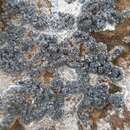The churchyard lecanactis is a UK Biodiversity Action Plan Priority Species, the Species Action Plan, which is lead by the wild plant charity Plantlife, aims to maintain the existing populations and to create three new colonies by 2005 (2). In addition, Plantlife has included the churchyard lecanactis on its Back From the Brink programme (4) and has produced a leaflet 'Churchyard Lecanactis: old walls can harbour secrets', available on request from Plantlife (
enquiries@plantlife.org.uk) (8). In 1990 the British Lichen Society set up the Churchyards Project, this project is concerned with research, conservation and education on lichens of churchyards (5). Regular survey work is carried out, and leaflets containing conservation guidelines have been produced (5).

